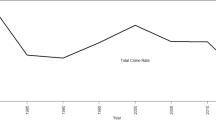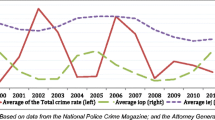Abstract
Taiwan is known for rapid economic growth, but in 1988, the government ended 40 years of martial law, resulting in greater political and social freedoms. This paper explores the influence of economic, social, and political structures on crime in the Republic of China on Taiwan. A time series analysis examines the structural correlates of crime in Taiwan from 1964 to 1990. Both total crime and burglary/larceny rates are regressed on seven independent variables derived from various theoretical perspectives. The results support Hagan's power-control and Christie's crime-industry perspectives for total crime, while measures assessing lack of economic means and the economic deprivation were significant for burglary/larceny.
Similar content being viewed by others
References
Berk, Richard, Alec Campbell, Ruth Klap and Bruce Western, “The Deterrent Effect of Arrest in Incidents of Domestic Violence: A Bayesian Analysis of Four Field Experiments,”American Sociological Review, 1992, (57: 5), 698–708.
Biles, David, “Crime and Imprisonment: A Two-Decade Comparison between England, Wales, and Australia,”British Journal of Criminology, 1983 (23: 2), 150–172.
Bowker, Lee H. “Crime and the Use of Prisons in the United States: A Time-Series Analysis,”Crime and Delinquency, 1981 (27: 2), 206–212.
Braithwaite, John. “Poverty, Power, White-Collar Crime and the Paradoxes of Criminological Theory,”The Australian and New Zealand Journal of Criminology, 1991 (24: 1), 40–58.
Bursik, Robert J., Jr., Harold G. Grasmick and Mitchell B. Chemlin, “The Effect of Longitudinal Arrest Patterns on the Development of Robbery Trends at the Neighborhood Level,”Criminology, 1990 (28: 3), 431–450.
Cantor, David and Kenneth C. Land, “Unemployment and Crime Rates in the Post-World War II United States: A Theoretical and Empirical Analysis,”American Sociological Review, 1985 (50: 3), 317–332.
Carroll, Lee and Pamela Irving Jackson, “Inequality, Opportunity, and Crime Rates in Central Cities,”Criminology, 1983 (21: 2), 178–194.
Christie, Nils, Crime Control as Industry (London: Routledge, 1993).
Cloward, Richard A. and Lieut E. Ohlin,Delinquency and Opportunity (New York: Free Press, 1960).
Cohen, Albert K.,Delinquent Boys: The Culture of the Gang (New York: Free Press, 1955).
Cohen, Lawrence and Marcus Felson, “Social Change and Crime Rate Trends: A Routine Activity Approach,”American Sociological Review, 1979 (44: 4), 588–608.
Cohen, Lawrence E. and Kenneth C. Land, “Age Structured and Crime: Symmetry versus Asymmetry and the Projection of Crime Rates through the 1990s,”American Sociological Review, 1987 (52: 2), 170–183.
Crime-Cracker,The Economist, 1990 (15: 7658), 40, 42.
Currie, Elliott,Confronting Crime (New York: Pantheon Books, 1985).
Danziger, Sheldon, “Explaining Urban Crime Rates,”Criminology, 1976 (14: 2), 291–295
Devine, Joel A., Joseph F. Sheley and M. Dwayne Smith, “Macroeconomics and Social-Control Policy Influences on Crime Rate Changes, 1948–1985,”American Sociological Review, 1988 (53: 3), 407–420.
Directorate-General of Budget, Accounting and Statistics,Social Indicators in Taiwan Area of the Republic of China 1990 (Taipei, Taiwan: Executive Yuan, 1991).
Garofalo, James, “Reassessing the Lifestyle Model of Criminal Victimization,” in Michael R. Gottfredson and Travis Hirschi (Eds),Positive Criminology (Newbury Park, CA: Sage, 1987
Gibbs, Jack P. and Glenn Firebaugh, “The Artifact Issue in Deterrence Research,”Criminology, 1990 (28: 2), 347–367.
Grasmick, Harold G, and Robert J. Bursik Jr., “Conscience, Significant Others, and Rational Choice: Extending the Deterrence Model,”Law and Society Review, 1990 (24: 3), 837–861.
Grasmick, Harold G., Robert J. Bursik, and Bruce J. Arneklev, “Reduction in Drunk Driving as a Response to Increased Threats of Shame, Embarrassment, and Legal Sanctions,”Criminology, 1993 (31: 1), 41–67.
Greenberg, David, “The Incapacitative Effects of Imprisonment: Some Estimates,”Law and Society Review, 1975 (9: 4), 541–580.
Hagan, John,Structural Criminology, (New Jersey: Rutgers University Press, 1989).
Jacobs, David and David Britt, “Inequality and Police Use of Deadly Force,”Social Problems, 1979 (26, 4), 403–412.
Jacobs, David, “Inequality and Economic Crime,”Sociology and Social Research, 1982 (66: 1), 12–26.
Junger-Tas, Josine, “An Empirical Test of Social Control Theory,”Journal of Quantitative Criminology, 1992 (8: 1), 9–27.
Krahn, Harvey, Timothy F. Hartnagel, and John W. Gartrell, “Income Inequality and Homicide Rates: Cross-National Data and Criminological Theories,”Criminology, 1986 (24: 2), 269–295.
Kristof, Nicholas D., “A Dictatorship that Grew up,”The New York Times Magazine, 1992 (February 16), 16–21, 53, 56–58.
Kuo, Shirley W.Y.,The Taiwan Economy in Transition (Boulder, CO. Westview Press, 1983),
Lynch, James P. and David Cantor, “Ecological and Behavioral Influences on Property Victimization at Home: Implications for Opportunity Theory,”Journal of Research in Crime and Delinquency 1992 (29: 3), 335–362.
Meddis, Sam Vincent, “Is the Drug War Racist,”U.S.A. Today, 1993 (July 23), 1A-2-A, 6-A.
Merton, Robert K.,Social Theory and Social Structure (Glencoe, IL: Free Press, 1968).
National Bureau of Criminal Investigation,Crime Statistics of the Republic of China (Taipei, Taiwan: National Police Administration, Ministry of Interior, 1965–1991).
Neter, John and William Wasserman,Applied Linear Statistical Models (Homewood, IL: Richard D. Irwin, Inc, 1974).
Norris, Clive, Nigel Fielding, “Charles Kemp and Jane Fielding, “Black and Blue: An Analysis of the Influence of Race on Being Stopped by the Police,”British Journal of Sociology, 1992 (43: 2), 207–224.
Pate, Antony M., and Edwin E. Hamilton, “Formal and Informal Deterrents to Domestic Violence: The Dade County Spouse Assault Experiment,”American Sociological Review, 1992 (57: 5), 691–697.
Paternoster, Raymond, Linda Saltzman, Gordon Waldo, and Theodore Chiricos, “Perceived Risk and Social Control: Do Sanctions Really Deter?Law and Society Review 1983 (17: 3), 457–479.
Pepinsky, Harold E. and Paul Jesilow,Myths that Cause Crime (Cabin John, MD: Seven Locks, 1984).
Robinson, Cyril D. and Richard Scaglion, “The Origin and Evolution of the Police Function in Society: Notes Toward a Theory,”Law and Society Review, 1987 (21: 1), 109–153.
Shapiro, Perry and Harold L. Votey, Jr., “Deterrence and Subjective Probabilities of Arrest: Modeling Individual Decisions to Drink and Drive in Sweden,”Law and Society Review, 1984 (18, 4), 583–604.
Sherman, Lawrence W.,Policing Domestic Violence: Experiments and Dilemmas (New York: Free Press, 1992).
Sherman, Lawrence W., Douglas A. Smith, Jannell D. Schmidt, and Dennis P. Rogan, “Crime, Punishment, and Stake in Conformity: Legal and Informal Control of Domestic Violence,”American Sociological Review, 1992 (57: 5), 680–690.
Smith, Douglas A., and Patrick R. Gartin, “Specifying Specific Deterrence: The Influence of Arrest on Future Criminal Activity,”American Sociological Review, 1989 (54: 1), 94–106.
Sviridoff, Michelle and James W. Thompson, “Links between Employment and Crime: A Qualitative Study of Riker's Island Releases,”Crime and Delinquency, 1983, (29: 2), 195–212.
Thornberry, Terence P. and Margaret Farnworth, “Social Correlates of Criminal Involvement: Further Evidence of the Relationship between Social Status and Criminal Behavior,”American Sociological Review, 1982 (47: 4), 505–518.
Tillman, Robert, and Pontell, Henry N., “Is Justice Collar-Blind? Punishing Medicaid Provider Fraud,”Criminology, 1982 (30: 4, 547–574.
Tulder, Frank Van, “Crime, Detection Rate, and the Police: A Macro Approach,”Journal of Quantitative Criminology, 1992 (8: 1), 113–131.
Turk, Austin T.,Political Criminality — The Defiance and Defense of Authority (Beverly Hills: Sage Publications, 1982).
Williams, Kirk R. and Richard Hawkins, “The Meaning of Arrest for Wide Assault,”Criminology, 1989 (27: 1), 163–181.
Yanji, Chuan, Mei-Chen Lee, and Jui Huang,An Analysis of Crime Problems in Taiwan (Taipei, Taiwan: Crime Institute of the Ministry of Justice, 1991).
Zan, Wan-Dai, “Stiff Sentence Deters Crime,”Central Daily News, 1992 (September 20).
Zedlewski, Edwin W., “Deterrence Finding and Data Sources: A Comparison of the Uniform Crime Reports and the National Crime Surveys,”Journal of Research in Crime and Delinquency, 1982 (20: 2), 262–276.
Zimring, Franklin E. and Gordon J. Hawkins,Deterrence: The Legal Threat in Crime Control (Chicago: University of Chicago Press, 1973).
Author information
Authors and Affiliations
Rights and permissions
About this article
Cite this article
Denq, F., Vaughn, M.S. & Huang, F.F.Y. Correlates of crime in Taiwan. Crime Law Soc Change 21, 267–285 (1994). https://doi.org/10.1007/BF01307967
Issue Date:
DOI: https://doi.org/10.1007/BF01307967




